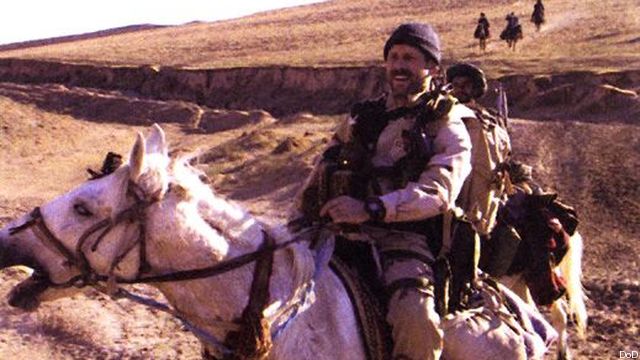
Special Operator on horseback in Afghanistan
WASHINGTON: The generals and admirals in charge of equipping and fielding the nation’s special operations forces are about to get some help in the form of an 11 percent budget increase.
Just as the Trump administration has pledged to pump billions more into the defense budget, the Special Operations Command will also add about 1,700 personnel to its perpetually growing 71,200 force size.
That money will boost the command’s budget to a record $13.6 billion ($9.1 billion in base funding and another $4.6 billion OCO), which will help pay for resetting old equipment and bankrolling new forays into Artificial Intelligence (AI) and software development that leaders say will help them meet Defense Secretary Jim Mattis’ directive to become more “lethal.”

MH-60 Blackhawk from 23rd Special Tactics Squadron
At a panel discussion Thursday just blocks from the Pentagon, the four generals who lead the Army, Navy, Air Force, and Navy’s commando wings laid out the basics of what they’re looking for – precision guided weapons, better ways to communicate between services, advances in AI and technologies that would allow their operators in the field to identify threats more quickly – and hit them with precision.
But more tech doesn’t mean that, in the end, there won’t be grunts directing it.
“I have a hard time looking forward to the future where that human contact and connection is removed from the equation,” said Lt. Gen. Kenneth Tovo, head of Army Special Operations Command. War is still a human activity, that requires moral judgments and decisions that can’t be left to software algorithms alone, he said. “We’ve got a lot of kinetic lethal capability, but it comes down to how to you sort through all of the data, and apply all that lethal capability…. We’re still talking about a human endeavor.”
But introducing more and more AI to the battlefield, and fielding smarter, learning software programs does present the possibility of changing what warfighting looks like, and who is qualified to do it. Rear Adm. Timothy Szymanski, commander of Naval Special Warfare Command, said in the future his teams “might look like a fat guy with glasses,” because advanced weaponry and artificial intelligence can carry more of the battlefield burden.
That day is still far off, but the groundwork is already being laid down.
The generals on the panel all affirmed they generally support initiatives like the Ash Carter-era DIUX program, which is trying to marry the Silicon Valley tech industry with suitors at the Pentagon. The smaller SOFWERX, based in Tampa, Fla., is doing the same thing on a different scale for SOCOM. The ultimate success of both programs remains an open question, as small tech firms remain wary of getting into bed with the Pentagon for a variety of reasons, including angering mega-consumer China (who’s already stolen much of the information) to having to divulge their intellectual property secrets to Pentagon bureaucrats.
Patrick Flood, the senior national security policy advisor for Rep. Don Bacon, a Nebraska Republican on the House Armed Services Committee, said the Hill is very focused on speeding up acquisition for SOCOM after years of sequestration had ripple effects across the armed forces that requires quick and sustained action to counteract.
But Taylor Andreae, legislative director for Rep. Joe Wilson, the GOP chairman of the HASC readiness subcommittee, added that the Hill has “been supportive of, but wary of DIUX,” since it has yet to prove itself.
Andreae said that while SOCOM’s OCO budget is roughly half of the command’s base ask, the commanders he has spoken with are eager to move those program lines into the base budget. He said his office is open to sitting down with OMB Director Mick Mulvaney — who when he was a congressman often railed against OCO budgets — to move OCO into the base.
In the near-term, however, the advances that special operations commanders are somewhat more modest. Maj. Gen. Carl Mundy, head of MARSOC, said that while AI is great, he’s currently focused on fielding new ground-launched precision strike weapons, which he wants to link up with drones as small as ScanEagles or Ravens. The idea, as simple and as old as warfare itself, is to allow his Marine Raiders to quickly peek over the next hill and eliminate the threat, without ever being seen.
Air Force awards SNC $13B contract for new ‘Doomsday’ plane
The win is a major victory for the firm in a competition that saw the surprise elimination of aerospace giant Boeing.


























